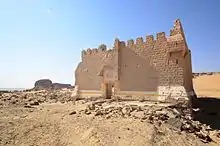Al-Mudawara Castle
Al-Mudawara Castle, or Jagiman Castle, is a desert castle located near the Jordanian village of Al-Mudawara, 350 km south of Amman and 15 km from the Jordanian-Saudi border. It was used in the Mamluk and Ottoman eras as a stop for caravans of Hajj, and the last pilgrim stations to Al-Shami before the start of the sandy plain in northern Hijaz.[1]

History
The first construction of this castle was during the period of the Arab prince Salama bin Fawaz bin Rashid Al-Mufarrajah Lami al-Ta’i, the leader of the Arab tribes in the region that is now Jordan, in the year 1495, i.e. the late Mamluk rule of southern Bilad al-Sham.[2] Salama bin Fawaz was the leader of the Lam and Bani Uqba tribes and others that inhabited the Badia at that time.[3] And Arab tribes, and since previous ages, have been concerned with protecting the convoys of the Levant and the Egyptian pilgrims that cross their regions.
There was no mention of the citadel in the sources until the Ottomans rebuilt it during the period of rule, and Abdullah Pasha guided me to the governor of Damascus[4](1142-1145 AH / 1730-1733AD). It is mentioned in the name of the fortress of Jogivan, which is the name known to the Bedouins to date, and the castle: Castle of Mudevira.
Building
The castle is square shaped with ribs length of 19 m, and the maximum height of the walls is 9 m. At the four corners of the fortress, pillars were constructed one meter above the floor, on which small towers were built. In its walls there are small open holes in two rows, and its northern and western walls have terraces.[5] The walls are built of two types of stones, in which the upper parts differ from the lower parts, which reflects at least two periods in which the reconstruction was made, perhaps they are the difference between the first construction of the era of the Gezivan leader and the second by the Ottomans.
Entry to the castle is through a rectangular gate leading to a covered corridor with a barrel vault overlooking a central square measuring 8 x 8 m. The gate is surmounted by a large latch that stands out from the azimuth of the eastern wall, and measures 5.50 x 2.50 m. The ratchet has a front window and a narrow opening on each side. The central square is surrounded by two floors, each consisting of nine rooms, covered with barrel vaults. Ascending to the upper floor was carried out by two stone stairways erected on both sides of the corridor. And its accessories include a pond and a paved road.
References
- "قلعة المُدوَّرة (مُديفيره، بالتركية) الواقعة على طريق الحج القديم. المحطة الأولى في شبه الجزيرة العربية، 562 كيلومتراً من دمشق، 734 متراً فوق مستوى البحر. بداية السهل الرملي بشمال شبه الجزيرة العربية". www.wdl.org. June 15, 1916.
- موسوعة مكة المكرمة والمدينة المنورة - Google Books. March 17, 2020. ISBN 9781905122288. Archived from the original on 2020-03-17.
- ʻUmar, Samīrah Fahmī ʻAlī (2001)
- "al-Durar al-faraʼid al-munaẓẓamah fī akhbār al-ḥājj wa-tarīq Makkah al ... - Google Books". March 17, 2020. Archived from the original on 2020-03-17.
- "Discover Islamic Art - Virtual Museum - monument_ISL_jo_Mon01_19_ar". islamicart.museumwnf.org.
